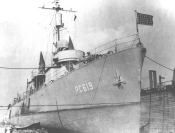NavSource Online:
Submarine Chaser Photo Archive
Dalhart (PC 619)
ex-PC-619
Nan - Uncle - Zebra - Baker


Dalhart served the Navies of the United States and Venezuela.


Specifications:
| Click on thumbnail for full size image |
Size | Image Description | Source | |
|---|---|---|---|---|
 |
60k | Dry Docked | Bob Daly/PC-1181 | |
 |
60k | |||
| Back To The Main Photo Index | Back To the Patrol Craft/Gunboat/Submarine Chaser Ship Type Index | Back to the Submarine Chaser (PC) Photo Index |
| Comments, Suggestions, E-mail Webmaster |
|
This page created by Joseph M. Radigan and maintained by Tom Bateman |